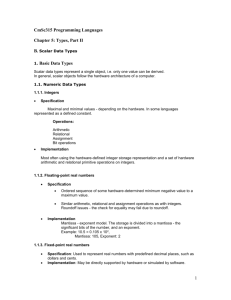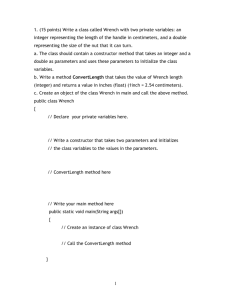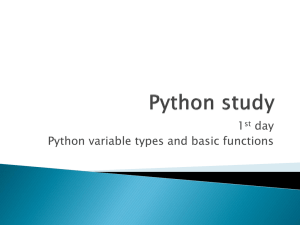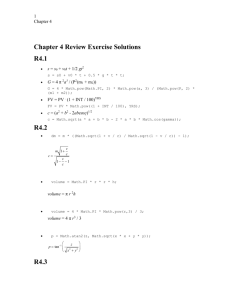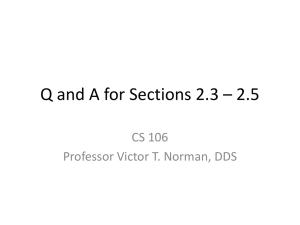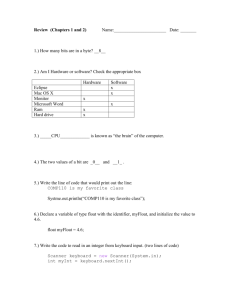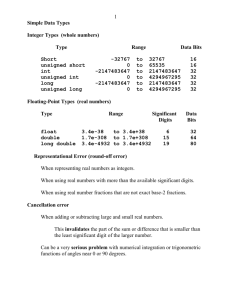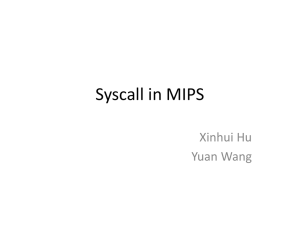Python Chapter 2
advertisement
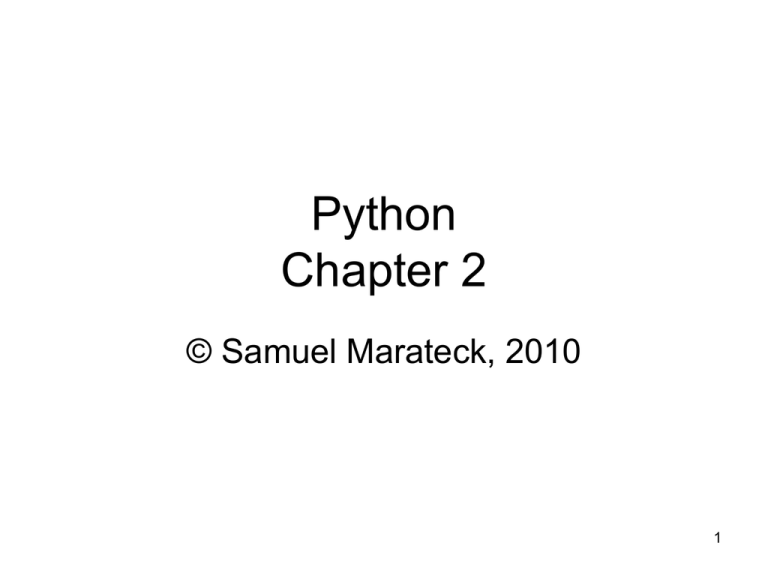
Python
Chapter 2
© Samuel Marateck, 2010
1
After you install the compiler, an icon
labeled IDLE (Python GUI) will appear on
the screen. If you click it, a window will
appear on the screen with some copyright
information. This window is called the shell.
IDLE is an acronym for Integrated
DeveLopment Environment which allows
you to write, edit and run a program.
2
Under that a prompt indicated by >>> will
appear. This prompts you to type some
Instruction. For instance,
>>> 3*4
This instructs the computer to multiply
3 times 4. The computer responds with
the product, 12. So you see:
3
>>>3*4
12
There are two types of numbers we will
be working with, integers and floats.
Let’s discuss integers first.
4
An integer has no decimal point. Examples
3, 456, -12. These are called integer literals
We first list symbols that you are familiar
with:
+ (addition), - (subtraction), * (multiplication),
and / (division).
5
We first list symbols that you are familiar
with:
+ (addition), - (subtraction), * (multiplication),
and / (division).
The first three produce an integer; but the /
produces a number with a decimal point.
6
The / produces a number with a decimal
point. So for instance typing 4/2 we get
>>> 4/2
2.0
The number 2.0 in called a floating point
number or simply, a float. It is an example
of a float literal.
7
There are three other operations you can use
with integers. Let’s try “//”, integer division:
>>> 7//2
3
Now 7/2 produces 3.5. The // operator
instructs the compiler to truncate the
results, i.e., lops off the part of the number
to the right of the decimal point. So 3.5 becomes 3
8
The second operator is %, the remainder
operator.
>>>7%2
1
Think of it this way, after 7//2 is performed,
the reminder is 1.
9
The third operator is ** which indicates
exponentiation, so
>>> 2**3
8
10
As oppose to other languages , there is no
limit to the number of digits in an integer.
So
>>>2**300
20370359763344860862684456884093781
61051468393665936250636140449354381
299763336706183397376
11
The operators have a precedence.
the operator with the highest precedence
is ** , then comes *, /, //, and %. These all
have the same precedence. Finally comes
+, -.
12
So 3*4 + 5 evaluates as 12+5 or 17.
How do you change the precedence, so that
the addition is done before the
multiplication?
.
13
.How do you change the precedence, so that the
addition is done before the multiplication?
Use (). So:
>>> 3*(4+5)
27
The operations in the () are always done first.
14
Similarly
>>> 3+2**4
19
How do you have the addition done before
the exponentiation?
15
To have the addition done before
the exponentiation, use ():
>>>(3+2)**4
625
or 5**4
16
Order of Operations
Operator
()
**
*
/
//
Operation
parentheses
exponentiation
multiplication
division
int division
Precedence
0
1
2
2
2
%
+
-
remainder
addition
subtraction
2
3
3
17
The computer scans the expression from
left to right,
first clearing parentheses,
second, evaluating exponentiations from left to
right in the order they are encountered
third, evaluating *, /, //, % from left to right
in the order they are encountered,
fourth, evaluating +, - from left to right
in the order they are encountered
18
How would you evaluate (3+3*5)/2*3?
Is it 18/6 i.e, 3 or is it 9*3?
19
These are the steps in evaluating the
Expression (3+3*5)/2*3
1.(3 + 15)/2*3
2. 18/2*3
3. 9*3
4. 27
20
The same operators that apply to integers
apply to floats. For instance.
In 5.2//2.1 python first uses regular division,
5.2/2.1 getting 2.4761904761904763 and
truncates the answer to 2.
21
Let’s do 6.3//2.1. You might expect to get
3.0 but you get 2.0. Why?
22
First, let’s calculate 6.3/2.1 using regular
division, the answer is 3.0 .
But floats are only approximations. The
answer that’s stored in memory is 2.999999
but is printed as 3.0. The // operation
truncates the results. So 6.3//2.1 is 2.99999
truncated to 2.0
23
So we’d expect 6.4//2.1 to produce 3.0
and it does.
24
Integers are stored in the memory exactly;
whereas stored floats are only
approximations.
25
There are math functions that can be
Imported. To do this, type import math. If
you then type
help(math),
the computer will type all the
math functions and what they do:
>>>import math
>>help(math)
26
Then if you want to find the √5, you type
>>>math.sqrt(5) and you get
2.2360679774997898
27
If you don’t want to type math each time
you use a function, type:
>>>from math import *
Then you can simply write:
>>>sqrt(5)
2.2360679774997898
28
If you just want to see the functions in the
math module, type
>>>dir(math)
and you get:
29
['__doc__', '__name__', '__package__',
'acos', 'acosh', 'asin', 'asinh', 'atan', 'atan2',
'atanh', 'ceil', 'copysign', 'cos', 'cosh',
'degrees', 'e', 'exp', 'fabs', 'factorial', 'floor',
'fmod', 'frexp', 'fsum', 'hypot', 'isinf', 'isnan',
'ldexp', 'log', 'log10', 'log1p', 'modf', 'pi',
'pow', 'radians', 'sin', 'sinh', 'sqrt', 'tan',
'tanh', 'trunc']
30
If you want to see the meaning of a
function, place the function name in the
() in help. Example:
>>>help(hypot)
This gives:
31
>>> help(hypot)
Help on built-in function hypot in module
math:
hypot(...)
hypot(x,y)
Return the Euclidean distance, sqrt(x*x +
y*y).
32
What does
>>> hypot(3,4)
give you?
33
>>> hypot(3,4)
5.0
34
Strings
A string is a group of one or more characters
sandwiched between “ or ‘. So “123sd” and
‘sde’ are strings. The characters “ and ‘
are called delimiters. If the string starts with
a “, it must end with a “; if it starts with a
‘ it must end with a ‘.
35
The + operator is overloaded. This means it
use depends upon context. We have seen
its use with floats and integers. It can also
be used with strings.
36
When used with strings, it joins them
creating a new string. So
>>>’abc’ + “123”
‘abc123’
37
To get the number of characters in a string
Use the len function.
>>>len(’abc’ + “123”)
6
38
Using Variables
A variable is a name associated with a
memory location. Examples
one = 12
two = 12.5
st = ‘123as’
One, two and s are variable names.
The type of the literal determines the variable
type. So one is an integer, two a float, and st a
string.
39
Variable names are case sensitive, so one
and One are two different variables (since
One is capitalized and one is not) and
describe two different memory locations.
40
Conversion functions
You can’t concatenate a string with another
type. So
>>> 'anc' + 3
produces
Traceback (most recent call last):
File "<pyshell#2>", line 1, in <module>
'anc' + 3
TypeError: Can't convert 'int' object to str
implicitly
41
The error message:
TypeError: Can't convert 'int' object to str implicitly
means that we have to explicitly make 3 in:
'anc' + 3
a string. The function str does this:
>>> 'anc' + str(3)
'anc3‘
The error is an example of a syntax error since it doesn’t follow the grammatical
rules of Python.
42
The following table show the conversion
functions.
43
function
use
Str()
Converts a number to
a string
Converts an object to an
integer and truncates.
Converts an object to an
integer and rounds.
Converts an object to a
44
float.
int()
round()
float
Examples:
>>>int(‘1234’)
1234
>>>float(‘1234’)
1234.0
>>>round(12.56)
13
>>>str(12.34)
’12.34’
45
When int() operates on a string, what is
embedded between the quotes must be
an integer, so
>>>int(’1.234’)
because 1.234 is a float, produces:
int('1.234')
ValueError: invalid literal for int() with base 10:
'1.234'
46
When an integer is used in an expression
containing a float, the result is also a float:
>>12 + 3.0
15.0
47

